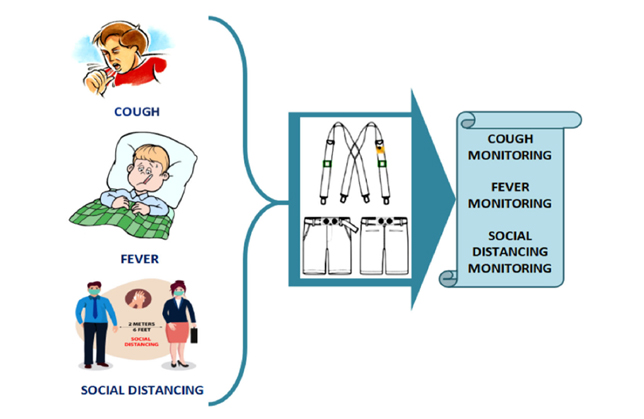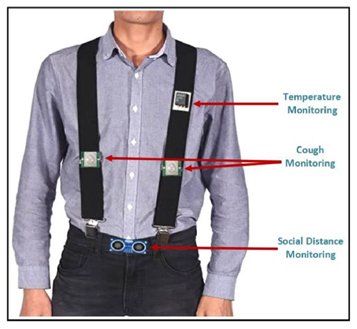 Persistent dry coughing and abnormally high body temperature are identified as more relevant risk factors associated with the COVID-19 crisis. Besides these, maintaining 6 feet social distancing norm was also recognized as a crucial factor. By taking these three features into consideration, the research group consisting of Dr Kshirasagar Sahoo, Assistant Professor, Department of Computer Science and Engineering at SRM University-AP have designed a smart, reliable and efficient COVID-19 tracking device model to monitor suspected infected people in public places. The device named “Smart COVID-Shield” utilising the IoT technology is equipped with a suspender and a belt to be placed over the clothes of the user which constitutes a cough detect unit, temperature detects unit and distance computing unit. Coughing and temperature patterns can be detected through the PIR sensor of the suspender while a belt with an ultrasonic sensor can be used to track people who violate the 6 feet social distancing norms in a real-time environment. A research paper titled “Smart COVID-shield: An IoT Driven Reliable and Automated Prototype for COVID-19 Symptoms Tracking” is published in Computing Journal as a part of the project.
Persistent dry coughing and abnormally high body temperature are identified as more relevant risk factors associated with the COVID-19 crisis. Besides these, maintaining 6 feet social distancing norm was also recognized as a crucial factor. By taking these three features into consideration, the research group consisting of Dr Kshirasagar Sahoo, Assistant Professor, Department of Computer Science and Engineering at SRM University-AP have designed a smart, reliable and efficient COVID-19 tracking device model to monitor suspected infected people in public places. The device named “Smart COVID-Shield” utilising the IoT technology is equipped with a suspender and a belt to be placed over the clothes of the user which constitutes a cough detect unit, temperature detects unit and distance computing unit. Coughing and temperature patterns can be detected through the PIR sensor of the suspender while a belt with an ultrasonic sensor can be used to track people who violate the 6 feet social distancing norms in a real-time environment. A research paper titled “Smart COVID-shield: An IoT Driven Reliable and Automated Prototype for COVID-19 Symptoms Tracking” is published in Computing Journal as a part of the project.
Abstract of the paper:
IoT technology is revolutionizing healthcare and is transforming it into more personalized healthcare. In the context of the COVID-19 pandemic, IoT’s intervention can help to detect its spread. This research proposes an effective “Smart COVID-Shield” that is capable of automatically detecting prevalent symptoms like fever and coughing along with ensuring social distancing norms are properly followed. It comprises three modules which include Cough Detect Module (CDM) for dry cough detection, Temperature Detect module (TDM) for high-temperature monitoring, and Distance Compute Module (DCM) to track social distancing norm violator. The device comprises a combination of a lightweight fabric suspender worn around the shoulders and a flexible belt wrapped around the waist. The suspender is equipped with a passive infrared (PIR) sensor and temperature sensor to monitor persistent coughing patterns and high body temperature and the ultra-sonic sensor verify 6 feet distance for tracking an individual’s social distancing norms. The developed model is implemented in an aluminium factory to verify its effectiveness. Results obtained were promising and reliable when compared to conventional manual procedures. The model accurately reported when body temperature rises. It outperformed thermal gun as it accurately recorded a mean of only 4.65 candidates with higher body temperature as compared to 8.59% with the thermal gun. A significant reduction of 3.61% on social distance violators was observed. Besides this, the latency delay of 10.32 s was manageable with a participant count of over 800 which makes it scalable.

This is a collaborative work of H. K. Tripathy, S. Mishra from School of Computer Engineering, KIIT Deemed to Be University, Bhubaneswar, Odisha, India and A. Nayyar from Graduate School, Faculty of Information Technology, Duy Tan University, Da Nang 550000, Vietnam.
Early detection of the coronavirus symptoms is one feasible means to restrict the spreading of coronavirus. The IoT enabled “Smart COVID-Shield” is developed and implemented in this study to monitor social distancing violators in crowded places. In future, all other COVID symptoms can be incorporated into the model to make it more effective and real-time. An emergency alert module can also be included as part of the model to create awareness among people. An enhanced security mechanism can be further embedded in the working model to prevent any data compromise and dilution in data availability.

